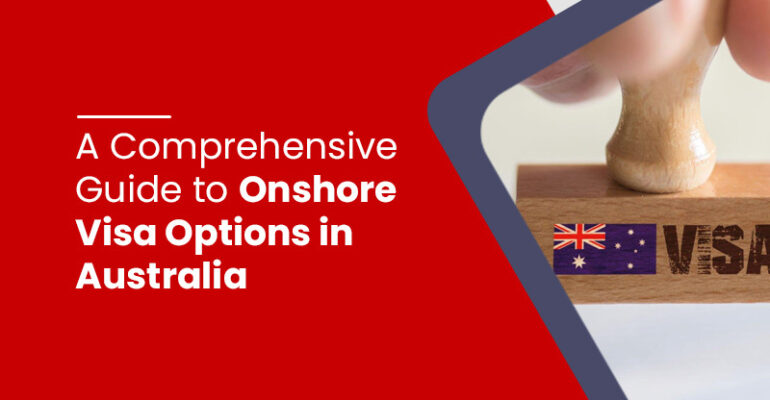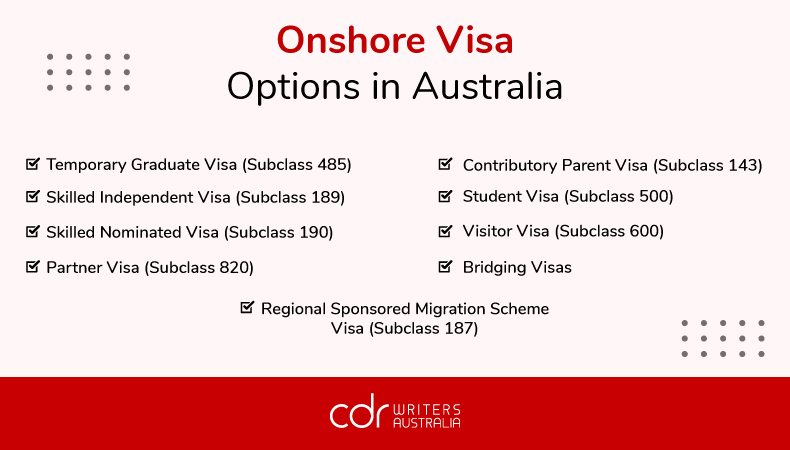A Comprehensive Guide to Onshore Visa Options in Australia

A Comprehensive Guide to Onshore Visa Options in Australia
Australia is a popular destination for immigrants looking to build a better life and explore new opportunities. Understanding the onshore visa options is crucial if you’re already in Australia and seeking to extend your stay or transition to permanent residency.
Australia continues to be a sought-after destination for individuals looking to build a better life and explore new opportunities. Understanding the onshore visa options becomes crucial if you’re already in Australia and seeking to extend your stay or transition to permanent residency.
In this comprehensive guide, we will delve into the various onshore visa pathways available, providing valuable insights to navigate the complexities of the Australian immigration system successfully.
Guide to Onshore Visa Options in Australia
When it comes to staying or establishing residency in Australia, onshore visas offer significant advantages for individuals already physically present. These visas provide stability and open avenues for work, study, and personal growth within Australia’s borders. To help you navigate the options available, here are some key onshore visa categories to consider:
Temporary Graduate Visa (Subclass 485)
The Temporary Graduate Visa is an attractive choice for international students who have recently completed their studies in Australia. It offers two streams: the post-study and graduate work streams.
The post-study work stream allows international graduates to work in Australia temporarily, gaining valuable professional experience. On the other hand, the graduate work stream is designed for students who have completed qualifications relevant to occupations in high demand in Australia.
Skilled Independent Visa (Subclass 189)
The Skilled Independent Visa is a permanent residency option for skilled workers not sponsored by an employer, state, or territory government. This visa category employs a points-based system to evaluate age, occupation, English language proficiency, educational qualifications, and work experience.
Meeting the minimum points requirement and satisfying other eligibility criteria can lead to a successful application for this visa, providing an excellent pathway to long-term residency in Australia.
Read More: Know everything about VETASSESS skill assessment. 🔥🔥
Skilled Nominated Visa (Subclass 190)
The Skilled Nominated Visa is another avenue to permanent residency for skilled workers. This visa requires nomination by a state or territory government agency, which adds additional points to the applicant’s overall score.
Nomination is typically granted to candidates whose skills and qualifications are in demand in a specific state or territory. The subclass 190 visa allows individuals to work and live permanently in Australia and contribute to the growth and development of their nominated region.

Regional Sponsored Migration Scheme Visa (Subclass 187)
The Regional Sponsored Migration Scheme (RSMS) Visa aims to address skill shortages in regional areas of Australia. This visa enables skilled workers to work and live in regional Australia permanently. An employer must nominate applicants in a designated regional area to be eligible. The RSMS visa offers the possibility of permanent residency and provides an opportunity to contribute to Australia’s regional growth and development.
Partner Visa (Subclass 820)
The Partner Visa is designed for individuals in a genuine and ongoing relationship with an Australian citizen, permanent resident, or eligible New Zealand citizen. This visa allows applicants to stay in Australia temporarily while their permanent partner visa application (subclass 801) is being processed.
The partner visa category recognizes the importance of maintaining and supporting genuine relationships and offers a path to long-term residency in Australia, fostering family unity and stability.
Contributory Parent Visa (Subclass 143)
The Contributory Parent Visa is tailored for parents of Australian citizens, permanent residents, or eligible New Zealand citizens who wish to live in Australia permanently. While this visa requires a higher application fee than the non-contributory parent visa, it provides a faster processing time.
The subclass 143 visa is an excellent option for parents who seek to be closer to their children and enjoy the benefits of living in Australia, including healthcare, education, and a high standard of living.
Student Visa (Subclass 500)
For those currently studying in Australia and wishing to continue their education, the Student Visa (subclass 500) allows for seamless progression. This visa permits enrollment in registered courses or study programs, part-time work opportunities, and an immersive experience within Australia’s vibrant education system.
Moreover, the subclass 500 visa can also serve as a pathway to skilled migration and further studies in Australia, providing a holistic educational journey.
Visitor Visa (Subclass 600)
The Visitor Visa is ideal for individuals who wish to visit family and friends or engage in short-term tourism activities in Australia. This visa permits stays of up to three, six, or twelve months, depending on circumstances. The subclass 600 visa offers flexibility and convenience for those desiring to explore Australia’s breathtaking landscapes and rich cultural heritage or spend quality time with their loved ones.
Bridging Visas
Individuals may need to wait for a decision on their substantive visa application during the visa application process. Bridging visas are temporary visas that allow them to remain lawfully in Australia during this waiting period. Understanding the different types of bridging visas, each with its conditions and eligibility criteria is crucial to maintaining lawful status while awaiting the final visa outcome.
Key Factors to Consider
Several factors should be considered when deciding on the most suitable onshore visa option. It is essential to thoroughly research and understand the specific visa requirements, processing times, application fees, and potential pathways for skilled migration assessments.
Each visa category has its own set of criteria and eligibility requirements. By conducting comprehensive research, individuals can make informed decisions and maximize their chances of a successful visa application, ultimately leading to a fulfilling and prosperous life in Australia.
Conclusion
Navigating the onshore visa options in Australia may seem daunting, but armed with the proper knowledge and information, you can make well-informed decisions about your future. Whether you’re a recent graduate, skilled worker, partner, or parent, exploring the available visa pathways will bring you closer to your goals of living and thriving in Australia.
Remember to consult with immigration experts and gather all the necessary documents to ensure a smooth and successful visa application process. With determination and proper planning, you can embark on an exciting journey toward a bright future in Australia.
Also, remember us for a free consultation and career guidance if you need help preparing documents such as the CDR report, ACS RPL report, KA02 report, and other reports.
FAQs
1. What is an onshore visa?
An onshore visa allows individuals to apply for further stay or residency while physically present in Australia.
2. What is the Temporary Graduate Visa?
The Temporary Graduate Visa (subclass 485) is for international students who have recently completed their studies in Australia and offers work opportunities.
3. How can I apply for a Skilled Independent Visa?
The Skilled Independent Visa (subclass 189) is for skilled workers not sponsored by an employer, state, or territory government and requires meeting minimum points requirements.
4. What is a Skilled Nominated Visa?
The Skilled Nominated Visa (subclass 190) is for skilled workers nominated by a state or territory government agency and offers a pathway to permanent residency.
5. Who can apply for the Regional Sponsored Migration Scheme Visa?
The Regional Sponsored Migration Scheme Visa (subclass 187) is for skilled workers nominated by an employer in a designated regional area.
6. What is a Partner Visa?
The Partner Visa (subclass 820) is for individuals in a genuine and ongoing relationship with an Australian citizen, permanent resident, or eligible New Zealand citizen.
7. Who can apply for the Contributory Parent Visa?
The Contributory Parent Visa (subclass 143) is for parents of Australian citizens, permanent residents, or eligible New Zealand citizens.
8. What is the Student Visa for?
The Student Visa (subclass 500) allows individuals to study in Australia, enroll in registered courses, and work part-time.
9. Who can apply for the Visitor Visa?
The Visitor Visa (subclass 600) is for individuals visiting family and friends or engaging in short-term tourism activities in Australia.
10. What are Bridging Visas?
Bridging Visas are temporary visas that allow individuals to remain lawfully in Australia while waiting for a decision on their substantive visa application.

